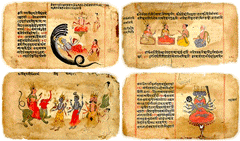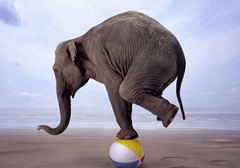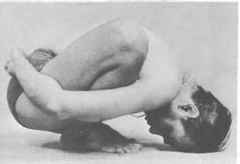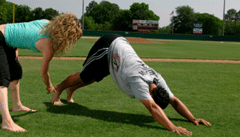 |
The Vedas (Sanskrit véda वेद, “knowledge”) are a large body of texts originating in ancient India. Composed in Vedic Sanskrit, the texts constitute the oldest layer of Sanskrit literature and the oldest scriptures of Hinduism. Hindus consider the Vedas to be apauruṣeya (“not of human agency”). They are supposed to have been directly revealed, and thus are called śruti (“what is heard”), distinguishing them from other religious texts, which are called smṛti (“what is remembered”). In Hindu tradition, the creation of Vedas is credited to Brahma.
Have an opinion? Join in by sending an email, or a tweet, using the links below… Twitter: @yogastudents |
 |
Pose of the week:Kurmasana
Tortoise Pose |
Monthly Archives: July 2014
Show #26 Yoga Radio: July 16, 2014 – Work-Life Balance (and Yoga)
 |
Work–life balance is a concept including proper prioritizing between “work” (career and ambition) and “lifestyle” (health, pleasure, leisure, family and spiritual development/meditation). The work-leisure dichotomy was invented in the mid-1800s. Paul Krassner remarked that anthropologists, use a definition of happiness that is to have as little separation as possible “between your work and your play”.Some theorists suggest that this blurred boundary of work and life is a result of technological control. Technological control “emerges from the physical technology of an organization”. In other words, companies use email and distribute smartphones to enable and encourage their employees to stay connected to the business even when they are not in the office. This type of control, as Barker argues, replaces the more direct, authoritarian control, or simple control, such as managers and bosses. As a result, communication technologies in the temporal and structural aspects of work have changed, defining a “new workplace” in which employees are more connected to the jobs beyond the boundaries of the traditional workday and workplace. The more this boundary is blurred, the higher work-to-life conflict is self-reported by employees. Have an opinion? Join in by sending an email, or a tweet, using the links below… Twitter: @yogastudents |
 |
Pose of the week:MalasanaGarland Pose |
Show #24 Yoga Radio: July 9, 2014 – Yoga and Technology
 |
What are the advantages of living in the digital age & what are the disadvantages as it relates to the practice of Yoga? Is ‘being online’ taking us away from the wholeness that Yoga offers us? Is it possible to have both, or is that just wishful thinking?
Have an opinion? Join in by sending an email, or a tweet, using the links below… Twitter: @yogastudents |
 |
Pose of the week:
Parivrtta Janu Sirsasana Revolved Head-of-the-Knee Pose |
Show #24 Yoga Radio: July 2, 2014 – Yoga and Sports
 |
Yoga has all sorts of benefits for athletes. For starters, it can help with muscular fitness and flexibility, says Ralph La Forge, a physiologist at the Duke University Medical Center in Durham, North Carolina: “Low-resistance hatha yoga is ideal for relaxing muscles that are tight from competition.”
But the mental steadfastness that the practice bestows may be its biggest benefit, La Forge says. Researchers studying this area have found that, of all yoga’s components, the one with the most influence on sports preparation and recovery is breathwork. It can help you become both relaxed and focused at the same time. Have an opinion? Join in by sending an email, or a tweet, using the links below… Twitter: @yogastudents |
 |
Pose of the week:
Paschimottanasana Seated Forward Bend |
